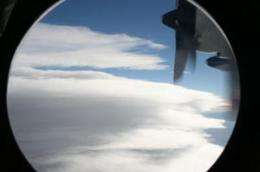First direct observations of biological particles in high-altitude ice clouds

A team of UC San Diego-led atmospheric chemistry researchers moved closer to what is considered the "holy grail" of climate change science when it made the first-ever direct detection of biological particles within ice clouds.
The team, led by Kerri Pratt, a Ph.D. student of atmospheric chemistry Professor Kim Prather, who also holds appointments at Scripps Institution of Oceanography as well as the Department of Chemistry and Biochemistry at UCSD, sampled water droplet and ice crystal residues at high speeds from an aircraft flying through clouds in the skies over Wyoming in fall 2007. Analysis of the ice crystals revealed that they were made up almost entirely of either dust or biological particles such as bacteria, fungal spores and plant material. While it has long been known that microorganisms or parts of them get airborne and travel great distances, this study is the first to yield in-situ data on their participation in cloud ice processes.
Results of the Ice in Clouds Experiment - Layer Clouds (ICE-L), funded by the National Science Foundation (NSF) and the National Center for Atmospheric Research (NCAR), appear May 17 in the advance online edition of the journal Nature Geoscience.
"If we understand the sources of particles that nucleate clouds and their relative abundance, then we can determine the impact of these different sources on climate," said Pratt.

The effects of tiny airborne particles called aerosols on cloud formation have been some of the most difficult aspects of weather and climate for scientists to understand. In the climate change science field, which derives many of its projections from computer simulations of climate phenomena, the actions of aerosols on clouds represent what scientists consider the greatest uncertainty in modeling predictions for the future.
"By sampling clouds in real time from an aircraft, these investigators were able to get information about ice particles in clouds at an unprecedented level of detail," said Anne-Marine Schmoltner of the NSF's Division of Atmospheric Sciences. "By determining the chemical composition of the very cores of individual ice particles, they discovered that both mineral dust, and, surprisingly, biological particles play a major role in the formation of clouds."
Aerosols, ranging from dust, soot, sea salt to organic materials, some of which travel thousands of miles, form the skeletons of clouds. Around these nuclei, water and ice in the atmosphere condense and grow leading to precipitation. Scientists are trying to understand how they form as clouds play a critical role by both cooling the atmosphere and affect regional precipitation processes.
ICE-L was the first aircraft-based deployment of the aircraft aerosol time-of-flight mass spectrometer (A-ATOFMS) nicknamed "Shirley," which was recently developed at UCSD with funding from NSF. The ICE-L team mounted the mass spectrometer and an ice chamber run by Colorado State University researcher Paul DeMott onto a C-130 aircraft operated by NCAR and made a series of flights through a type of cloud known as a wave cloud. The researchers performed in-situ measurements of cloud ice crystal residues and found that half were mineral dust and about a third contained nitrogen, phosphorus and carbon — the signature elements of biological matter.
The second-by-second analysis speed allowed the researchers to make distinctions between residues of water droplets and ice nuclei in real-time. Ice nuclei are rarer than droplet nuclei and are more likely to create precipitation.
The A-ATOFMS also allowed the unambiguous measurement of biological particles in the cloud ice, which scientists previously concluded serve as ice nuclei based on simulations in laboratory experiments and precipitation measurements. Based on modeling and the chemical composition of measured dust, the ICE-L team was able to identify the source of the dust as Asia or Africa. "This has really been kind of a holy grail measurement for us," said Prather. "Understanding which particles form ice nuclei, which occur at extremely low concentrations and are inherently difficult to measure, means you can further understand processes that result in precipitation. Any new piece of information you can get is critical."
The findings suggest that the biological particles that get swept up in dust storms help to induce the formation of cloud ice and that their region of origin makes a difference. Prather said initial evidence is increasingly suggesting that dust transported from Asia could be influencing precipitation in North America, for example.
Researchers hope to use the ICE-L data to design future studies timed to events when such particles may be playing a bigger role in triggering rain- or snowfall.
Source: University of California - San Diego (news : web)


















